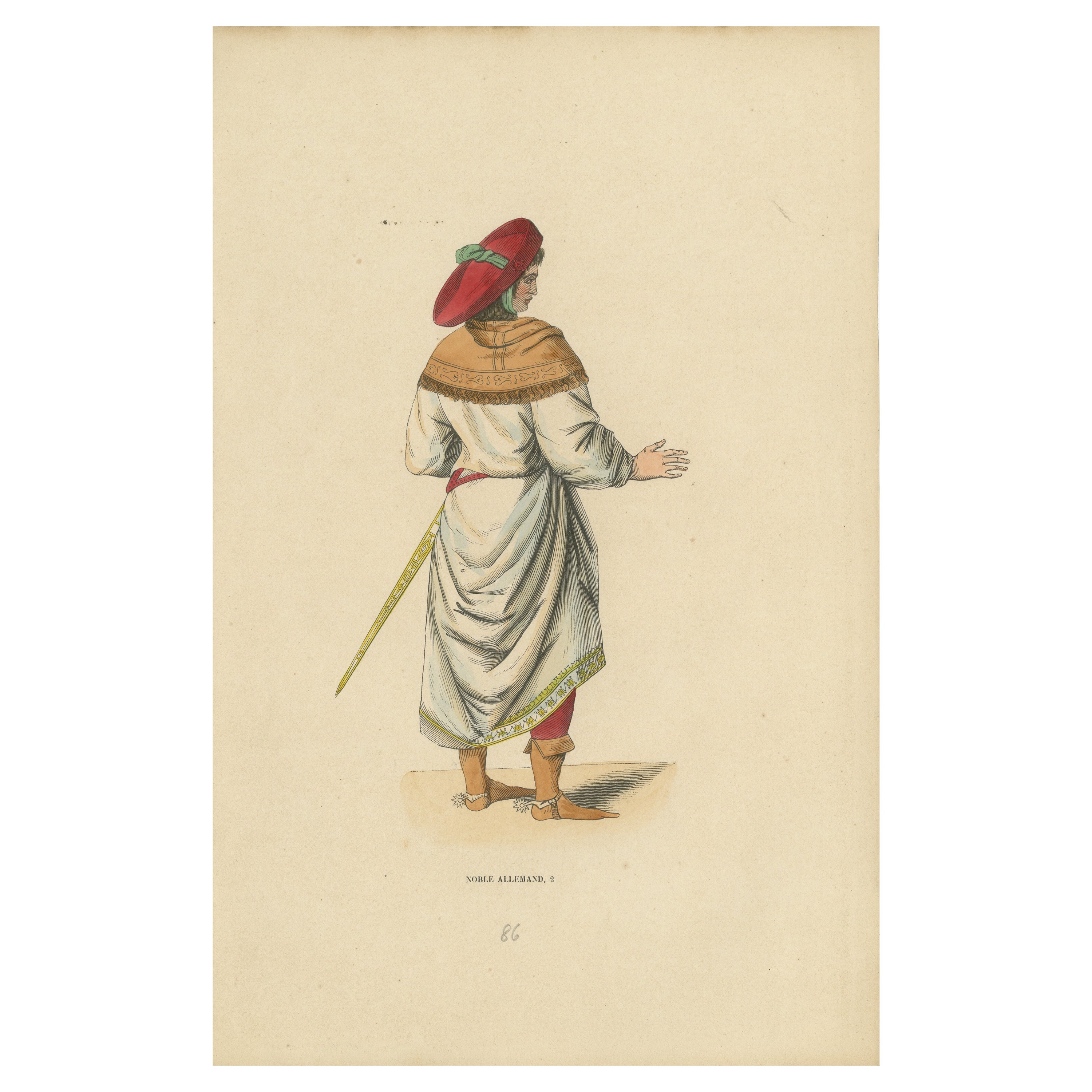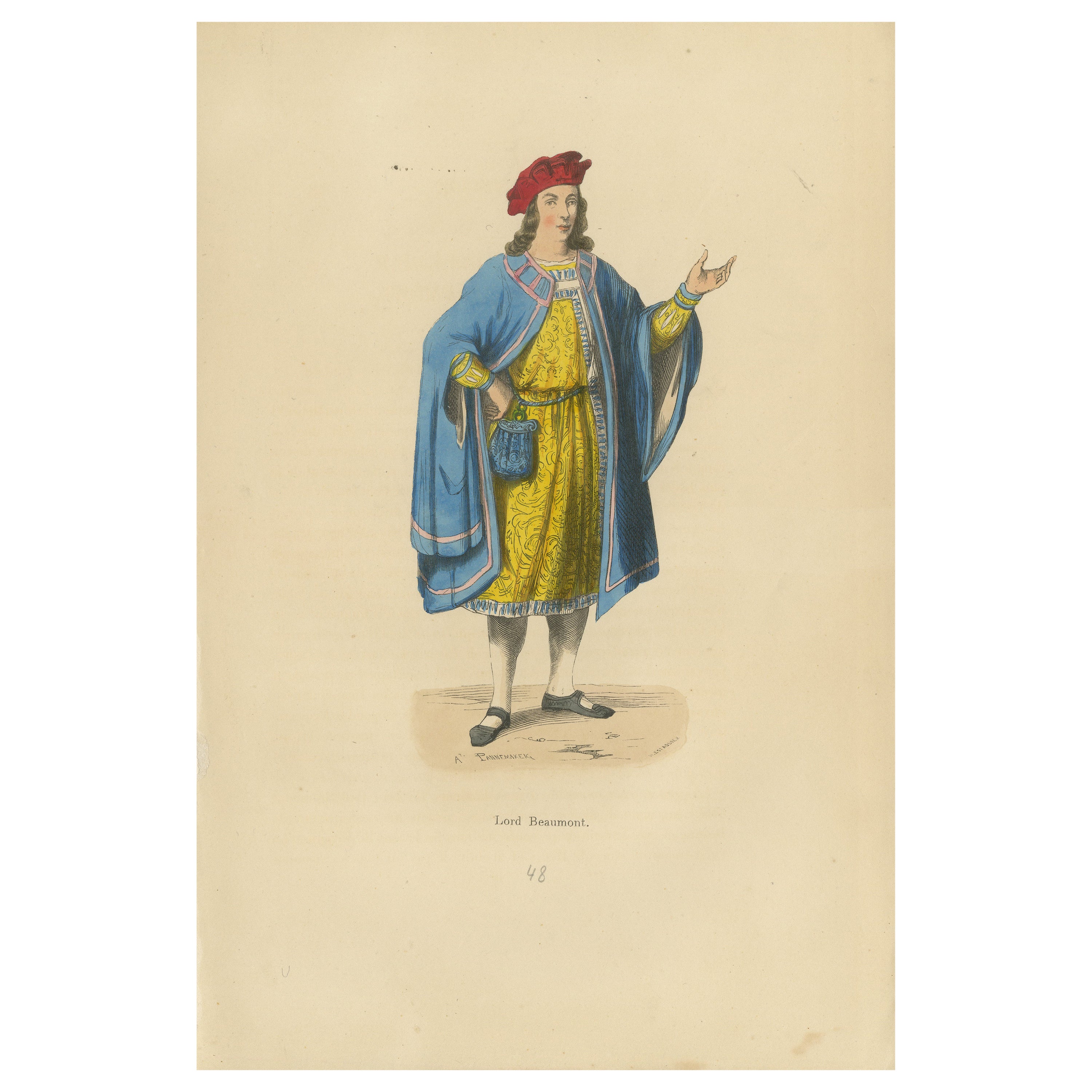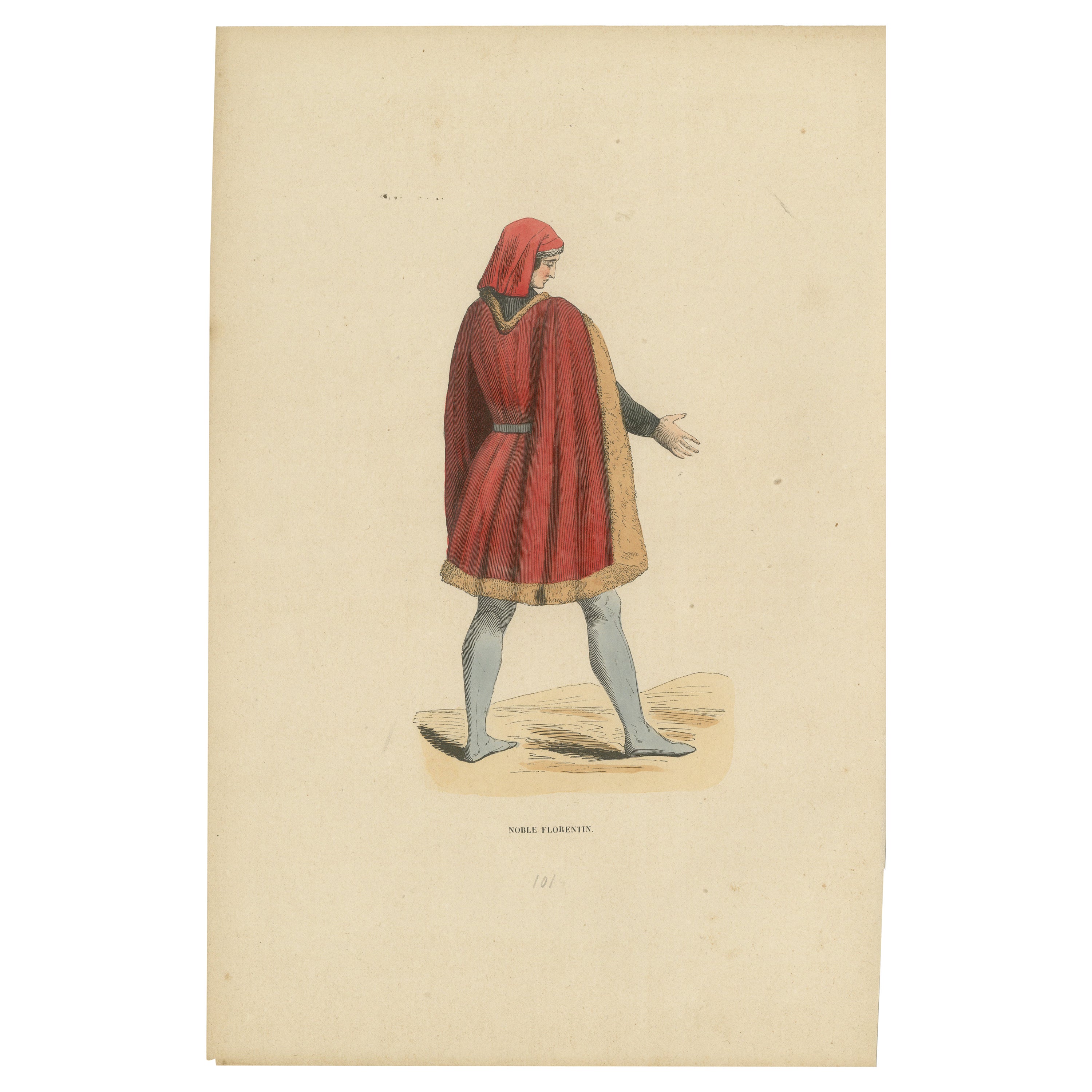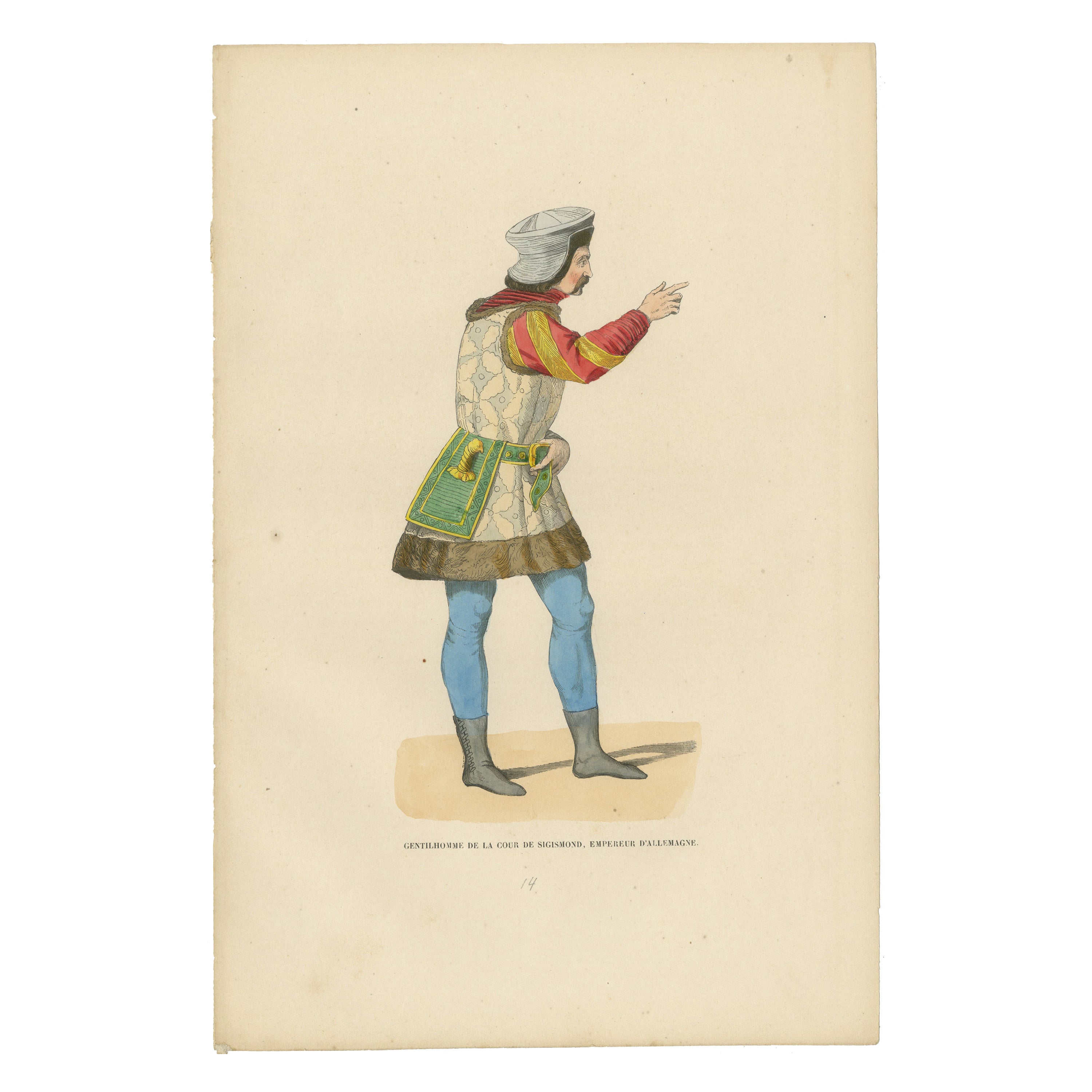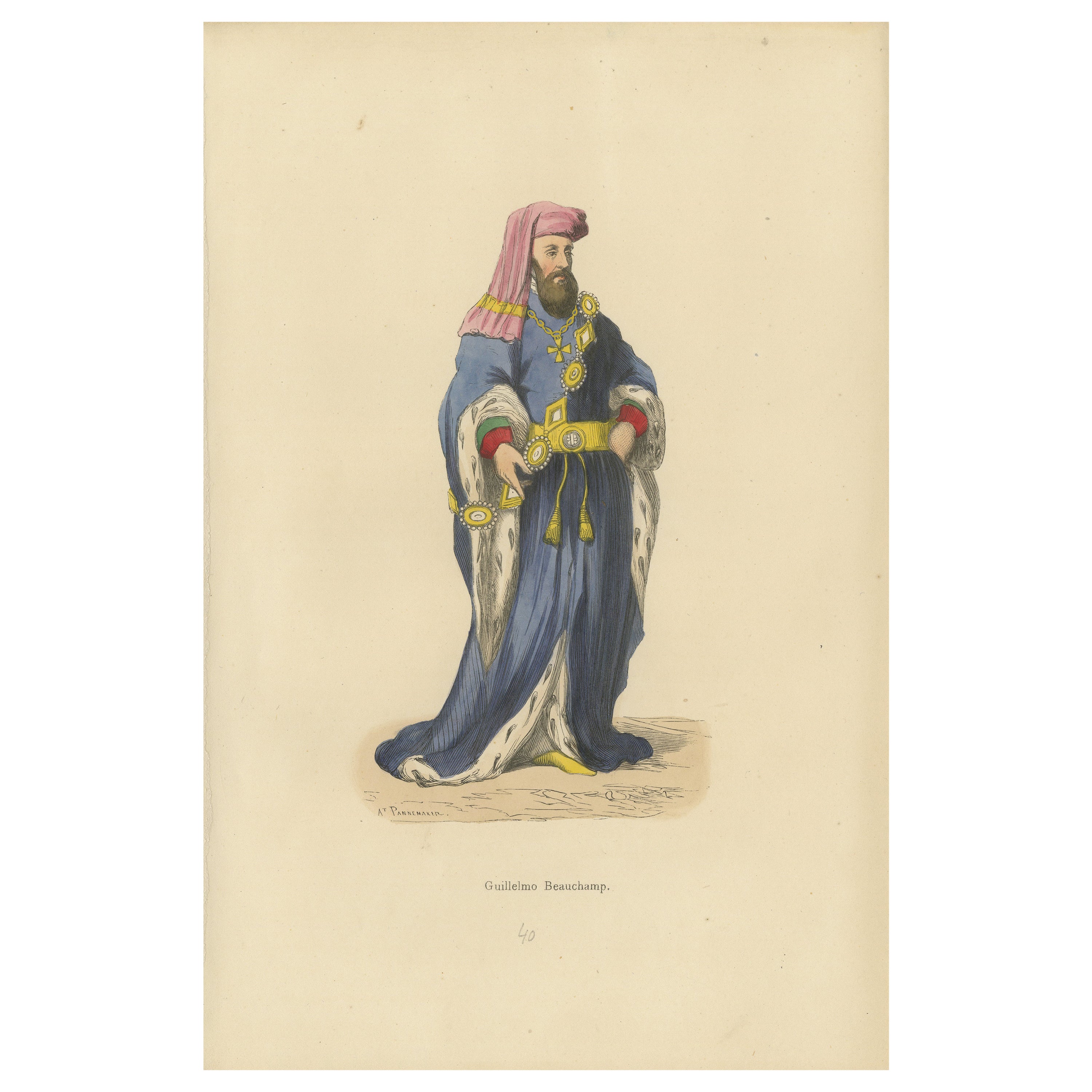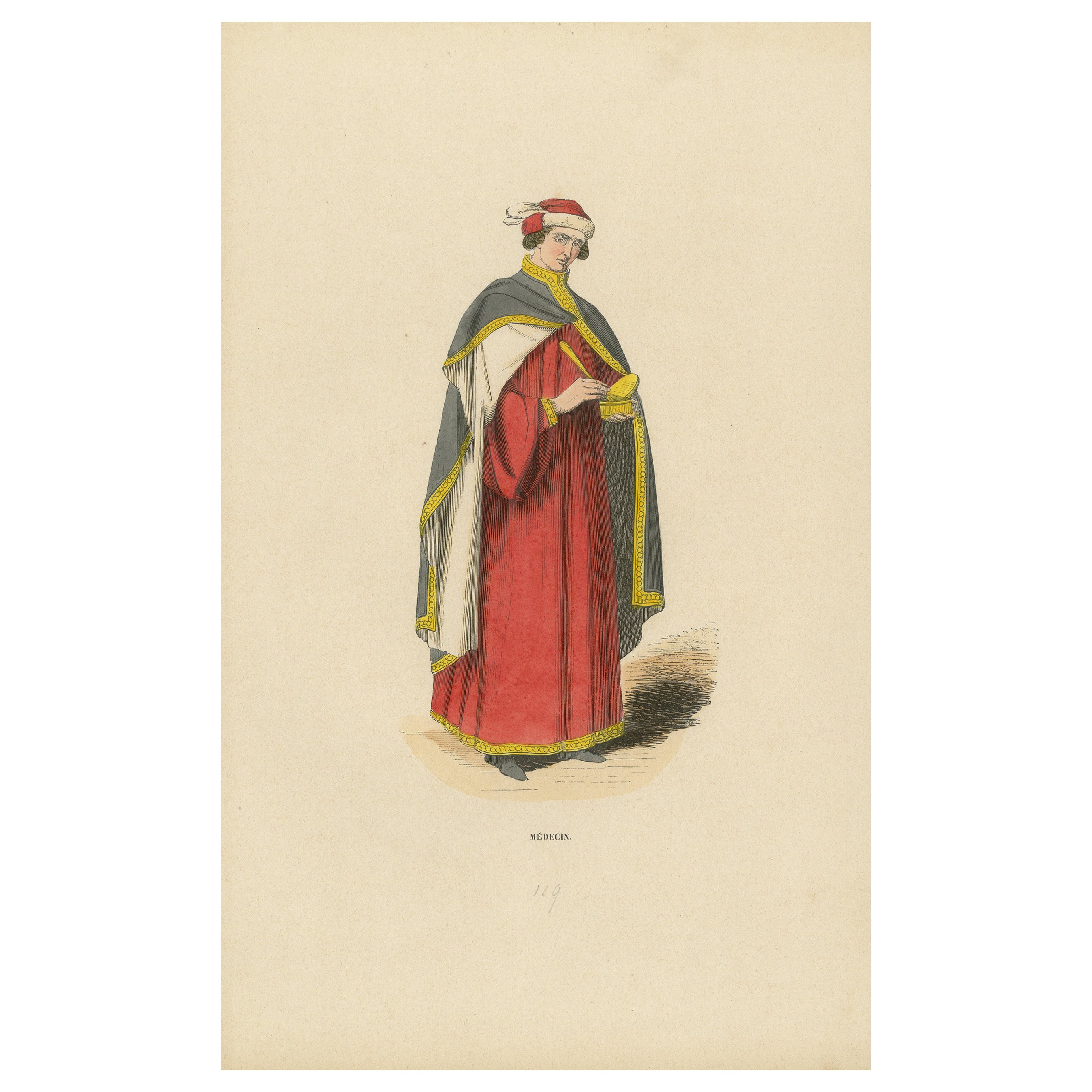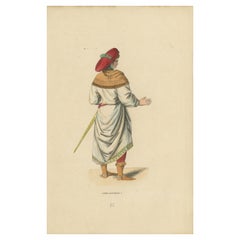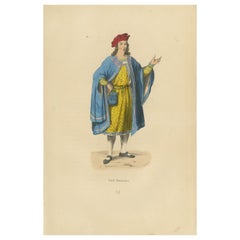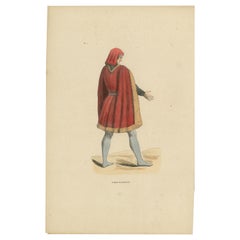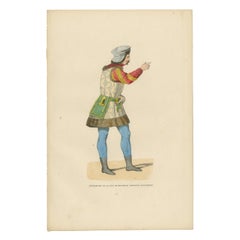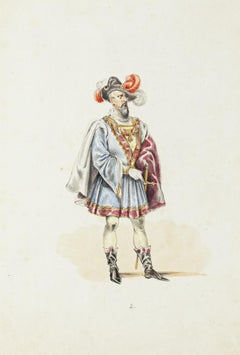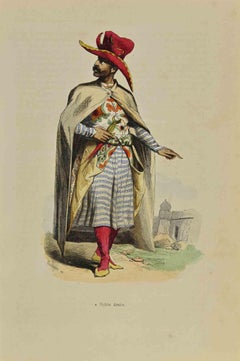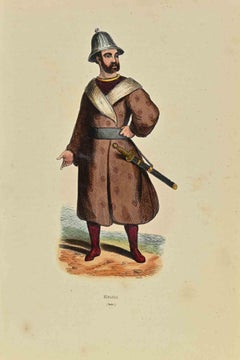Items Similar to Noble Bearing: A German Gentleman in Medieval Attire, 1847
Want more images or videos?
Request additional images or videos from the seller
1 of 6
Noble Bearing: A German Gentleman in Medieval Attire, 1847
$172.68
$215.8520% Off
£128.46
£160.5720% Off
€144
€18020% Off
CA$236.46
CA$295.5820% Off
A$262.91
A$328.6420% Off
CHF 137.28
CHF 171.6020% Off
MX$3,200.28
MX$4,000.3520% Off
NOK 1,751.61
NOK 2,189.5120% Off
SEK 1,641.17
SEK 2,051.4720% Off
DKK 1,096.19
DKK 1,370.2420% Off
Shipping
Retrieving quote...The 1stDibs Promise:
Authenticity Guarantee,
Money-Back Guarantee,
24-Hour Cancellation
About the Item
Title: "Noble Bearing: A German Gentleman in Medieval Attire from 'Costume du Moyen Âge'"
Description: This 1847 lithograph from the esteemed collection "Costume du Moyen Âge" showcases the elaborate attire of a German nobleman. The gentleman stands with an air of confidence, his hand extended as if engaged in conversation or issuing a command.
He is attired in a striking red doublet with white fur trim, a style that denotes his noble status. The doublet is fastened with a green belt at the waist, which accentuates the richness of his clothing. Over the doublet, he wears a blue surcoat emblazoned with heraldic symbols, suggesting a lineage of distinction and valor. The surcoat's short sleeves reveal the detailed undergarments, adding depth to the layered ensemble.
His hose are a vivid red, matching the doublet, and are met with contrasting black shoes, pointed in the fashion of the era. On his head sits a red chaperon with a long, flowing liripipe, giving him a distinguished and fashionable profile.
The nobleman's beard and hairstyle are meticulously groomed, befitting a man of his station. His posture and the direction of his gaze imply an engagement with an unseen audience or counterpart, perhaps in the matters of state or courtly discussion.
This lithograph serves not only as a historical reference to the fashion of the German aristocracy but also provides insight into the social customs and visual culture of the Middle Ages, where clothing was a powerful indicator of social standing and identity.
The colors have a nice glow over them. Historically, egg whites, known as glair, and sometimes egg yolk were indeed used in illumination and painting, particularly in manuscripts, to give colors a brighter appearance and to add a sheen or gloss to the work. This technique was quite common during the Middle Ages and into the Renaissance.
Egg whites can be applied as a varnish over pigments to enhance their brightness and to protect the colors. This application could make the colors appear more vivid and also add a slight glossy sheen to the surface of the image.
Egg yolk, on the other hand, was commonly used as a binding agent in paint. It forms the basis of tempera paint, a medium that was widely used before the advent of oil painting. Egg yolk helps to create a durable and long-lasting color that adheres well to various surfaces.
In the context of the print from 1847, it's less likely that egg whites or yolks were used directly on the print, as by that time, commercial printing processes would have been more advanced and less reliant on such manual methods. However, if this print is a representation of an earlier style or is meant to mimic the appearance of hand-painted manuscripts, the original artists might have employed techniques or materials that gave a similar effect to those achieved with egg-based binders and varnishes.
- Dimensions:Height: 10.63 in (27 cm)Width: 7.09 in (18 cm)Depth: 0 in (0.02 mm)
- Materials and Techniques:
- Period:
- Date of Manufacture:1847
- Condition:Good. Overal light toning and light soiling but the image itself clean and hand-colored almost 200 years ago and still in expliciet colors. Aged paper with typically warm, yellowish-brown hue, mostly around the edges. Study the images carefully.
- Seller Location:Langweer, NL
- Reference Number:Seller: BG-13635-1321stDibs: LU3054337929012
About the Seller
5.0
Recognized Seller
These prestigious sellers are industry leaders and represent the highest echelon for item quality and design.
Platinum Seller
Premium sellers with a 4.7+ rating and 24-hour response times
Established in 2009
1stDibs seller since 2017
2,511 sales on 1stDibs
Typical response time: <1 hour
- ShippingRetrieving quote...Shipping from: Langweer, Netherlands
- Return Policy
Authenticity Guarantee
In the unlikely event there’s an issue with an item’s authenticity, contact us within 1 year for a full refund. DetailsMoney-Back Guarantee
If your item is not as described, is damaged in transit, or does not arrive, contact us within 7 days for a full refund. Details24-Hour Cancellation
You have a 24-hour grace period in which to reconsider your purchase, with no questions asked.Vetted Professional Sellers
Our world-class sellers must adhere to strict standards for service and quality, maintaining the integrity of our listings.Price-Match Guarantee
If you find that a seller listed the same item for a lower price elsewhere, we’ll match it.Trusted Global Delivery
Our best-in-class carrier network provides specialized shipping options worldwide, including custom delivery.More From This Seller
View AllGerman Nobleman of the Middle Ages: Elegance in Profile, 1847
Located in Langweer, NL
Title: "German Nobleman of the Middle Ages: Elegance in Profile"
Description: This vibrant print, original antique and hand-colored, presents a German nobleman from the Middle Ages,...
Category
Antique 1840s Prints
Materials
Paper
$153 Sale Price
20% Off
Lord Beaumont in Courtly Attire, Costume Di Moyen Age, 1847
Located in Langweer, NL
The image shows a figure labeled as "Lord Beaumont," depicted in medieval attire. He is wearing a blue overcoat with a fur trim and a gold-patterned undergarment that extends to his ...
Category
Antique 1840s Prints
Materials
Paper
$124 Sale Price
20% Off
Florentine Nobleman of the Middle Ages, 1847
Located in Langweer, NL
Title: "Civilian Costume at the End of the 15th Century"
Description: The image is a print from a series the "Costume du Moyen Age" dated 1847, and titled "Costume Civil de la Fin du XVe Siècle," which translates to "Civilian Costume at the End of the 15th Century." It showcases a man of status, possibly a noble or a wealthy burgher, standing in a poised and confident manner.
He is attired in an ornate cloak covered in a complex pattern of fleur-de-lis and cross motifs, indicative of wealth and possibly a connection to royalty or high social rank. The cloak is open at the front to reveal a blue doublet with a belt, and he wears red hose—a fashion staple of the late medieval period. His footwear is also red, which stands out against the more subdued tones of his outfit.
On his head, he sports a fur-trimmed hat, adding to the luxuriousness of his attire. In one hand, he holds a long staff, which serves as both a walking aid and a symbol of authority. His other hand rests on the hilt of a dagger, further indicating his readiness to defend his status or engage in the political or civic matters of his time.
The artist has skillfully rendered the textiles and accessories with great care, emphasizing the fashion and social cues of the late 15th-century European society.
The colors have a nice glow over them. Historically, egg whites, known as glair, and sometimes egg yolk were indeed used in illumination and painting, particularly in manuscripts, to give colors a brighter appearance and to add a sheen or gloss to the work. This technique was quite common during the Middle Ages...
Category
Antique 1840s Prints
Materials
Paper
$124 Sale Price
20% Off
Courtly Splendor: A Nobleman at Emperor Sigismund's Court, 1847
Located in Langweer, NL
The image depicts a man identified as a "Gentilhomme de la cour de Sigismond, empereur d'Allemagne," which translates to "Gentleman of the court of Sigismund, Emperor of Germany."
This individual is portrayed in a profile stance, dressed in attire that is indicative of the high-status courtiers during the time of Emperor Sigismund, who reigned in the early 15th century. He is wearing a turban-like headgear, which reflects the influence of Eastern fashion on European court attire, possibly due to the Ottoman influence or the general exchange of culture during the Crusades and subsequent interactions.
His doublet is richly patterned and he has puffed sleeves in red, which were fashionable among the nobility during the period. The garment is accented with a decorative belt that holds what appears to be a purse or a pouch. He also sports tight blue hose and pointed shoes, which complete the ensemble typical of a nobleman or a high-ranking court official in the Holy Roman Empire.
Egg whites can be applied as a varnish over pigments to enhance their brightness and to protect the colors. This application could make the colors appear more vivid and also add a slight glossy sheen to the surface of the image.
Egg yolk, on the other hand, was commonly used as a binding agent in paint. It forms the basis of tempera paint, a medium that was widely used before the advent of oil painting. Egg yolk helps to create a durable and long-lasting color that adheres well to various surfaces.
In the context of the print from 1847, it's less likely that egg whites or yolks were used directly on the print, as by that time, commercial printing processes would have been more advanced and less reliant on such manual methods. However, if this print is a representation of an earlier style or is meant to mimic the appearance of hand-painted manuscripts...
Category
Antique 1840s Prints
Materials
Paper
$153 Sale Price
20% Off
William de Beauchamp in Noble Attire in An Original Handcolored Lithograph, 1847
Located in Langweer, NL
This original antique print portrays a medieval nobleman, identified as "Guillelmo Beauchamp," which may refer to William de Beauchamp, a prominent figure in English history. The nob...
Category
Antique 1840s Prints
Materials
Paper
$153 Sale Price
20% Off
Attire of a Medieval Scholar: The Learned Physician of the Middle Ages, 1847
Located in Langweer, NL
Title: "Attire of a Medieval Scholar: The Learned Physician of the Middle Ages"
This hand-colored lithograph, titled "Médecin" in the original French, is a detailed portrayal of a m...
Category
Antique 1840s Prints
Materials
Paper
$143 Sale Price
20% Off
You May Also Like
Persian Noble Man - Lithograph by Auguste Wahlen - 1844
Located in Roma, IT
Persian Nobleman is a lithograph made by Auguste Wahlen in 1844.
Hand colored.
Good condition.
At the center of the artwork is the original title "Noble Persan".
The work is part...
Category
1840s Modern Figurative Prints
Materials
Lithograph
Theatrical Costume - Original Lithograph - Early 20th Century
Located in Roma, IT
Theatrical Costume is a splendid hand lithograph engraved by Anonymous Artist in the Early XX Century.
The state of preservation of the artwork is exc...
Category
Early 20th Century Modern Figurative Prints
Materials
Lithograph
Noble Arab - Lithograph by Auguste Wahlen - 1844
Located in Roma, IT
Noble Arab is a lithograph made by Auguste Wahlen in 1844.
Hand colored.
Good condition.
At the center of the artwork is the original title "Noble Arabe".
The work is part of Sui...
Category
1840s Modern Figurative Prints
Materials
Lithograph
Eleuthe - Lithograph by Auguste Wahlen - 1844
Located in Roma, IT
Eleuthe is a lithograph made by Auguste Wahlen in 1844.
Hand colored.
Good condition.
At the center of the artwork is the original title "Eleuthe".
The work is part of Suite Moeu...
Category
1840s Modern Figurative Prints
Materials
Lithograph
Theatrical Costume - Original Lithograph - Early 20th Century
Located in Roma, IT
Theatrical Costume is a splendid hand lithograph engraved by Anonymous Artist in the Early 20th Century.
The state of preservation of the artwork is e...
Category
Early 20th Century Modern Figurative Prints
Materials
Lithograph
Imerethian Prince - Lithograph by Auguste Wahlen - 1844
Located in Roma, IT
Imerethian Prince is a lithograph made by Auguste Wahlen in 1844.
Hand colored.
Good condition.
At the center of the artwork is the original title "Imerethian Prince".
The work i...
Category
1840s Modern Figurative Prints
Materials
Lithograph
More Ways To Browse
Medieval Head
Green Egg Used
Art Deco Glass Shelving
Astronomical Clock
Baker New World Collection
Baroque Headboard
Bear Bookends
Bi Discs
Birds Of Paradise China
Black Cerused Dining Table
Black Iron Beds
Black Victorian Bed
Blanket Chest Dome
Boston Sculpture Company
Boston Terrier
Bow Front Glass Cabinet
Brass Antelope
Brass Crane Bird
